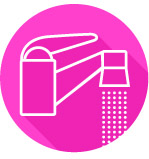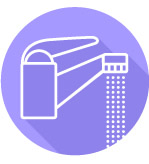In the RWA’s distribution system, water continuously flows through water mains. However, water flow in commercial building pipes is generally slower and dependent on water usage. Minimal or no water usage can affect water quality. Here are some tips to ensure water quality in commercial buildings.

Flushing
Flush building water systems after periods of minimal or no water usage. Commercial buildings are often vacant during weekends and holidays and experience periods of minimal or no water usage. This may cause a reduction in disinfection protection, which can lead to increased bacterial growth in building pipes. Locate the taps on each floor that are furthest from the floor's water service riser and flush the cold water taps for 10 minutes. Flush each fountain for one minute or install fountains with automatic flushing devices.

Water FIlters
Routinely change water filters. Water filters that are not routinely changed can accumulate impurities and promote bacterial growth. Replace water fountain filters according to the manufacturer's instructions.

Aerators
Routinely clean faucet aerators. Particles can collect in the aerator screen located at the tip of faucets. Aerators should be replaced annually.

Plumbing
Install lead-free plumbing fixtures to help minimize lead from entering the building's drinking water system. Install fixtures and fittings that contain 0.25 percent lead or less.

Water Usage
Monitor water usage. Monitoring water usage can assist building owners in identifying plumbing leaks.
In the RWA’s distribution system, water continuously flows through water mains. However, water flow in commercial building pipes is generally slower and dependent on water usage. Minimal or no water usage can affect water quality. Here are some tips to ensure water quality in commercial buildings.

Flushing
Flush building water systems after periods of minimal or no water usage. Commercial buildings are often vacant during weekends and holidays and experience periods of minimal or no water usage. This may cause a reduction in disinfection protection, which can lead to increased bacterial growth in building pipes. Locate the taps on each floor that are furthest from the floor's water service riser and flush the cold water taps for 10 minutes. Flush each fountain for one minute or install fountains with automatic flushing devices.

Water FIlters
Routinely change water filters. Water filters that are not routinely changed can accumulate impurities and promote bacterial growth. Replace water fountain filters according to the manufacturer's instructions.

Aerators
Routinely clean faucet aerators. Particles can collect in the aerator screen located at the tip of faucets. Aerators should be replaced annually.

Plumbing
Install lead-free plumbing fixtures to help minimize lead from entering the building's drinking water system. Install fixtures and fittings that contain 0.25 percent lead or less.

Water Usage
Monitor water usage. Monitoring water usage can assist building owners in identifying plumbing leaks.




